Tianfu Wang
Single-Step Latent Diffusion for Underwater Image Restoration
Jul 10, 2025Abstract:Underwater image restoration algorithms seek to restore the color, contrast, and appearance of a scene that is imaged underwater. They are a critical tool in applications ranging from marine ecology and aquaculture to underwater construction and archaeology. While existing pixel-domain diffusion-based image restoration approaches are effective at restoring simple scenes with limited depth variation, they are computationally intensive and often generate unrealistic artifacts when applied to scenes with complex geometry and significant depth variation. In this work we overcome these limitations by combining a novel network architecture (SLURPP) with an accurate synthetic data generation pipeline. SLURPP combines pretrained latent diffusion models -- which encode strong priors on the geometry and depth of scenes -- with an explicit scene decomposition -- which allows one to model and account for the effects of light attenuation and backscattering. To train SLURPP we design a physics-based underwater image synthesis pipeline that applies varied and realistic underwater degradation effects to existing terrestrial image datasets. This approach enables the generation of diverse training data with dense medium/degradation annotations. We evaluate our method extensively on both synthetic and real-world benchmarks and demonstrate state-of-the-art performance. Notably, SLURPP is over 200X faster than existing diffusion-based methods while offering ~ 3 dB improvement in PSNR on synthetic benchmarks. It also offers compelling qualitative improvements on real-world data. Project website https://tianfwang.github.io/slurpp/.
Unveiling the Learning Mind of Language Models: A Cognitive Framework and Empirical Study
Jun 16, 2025
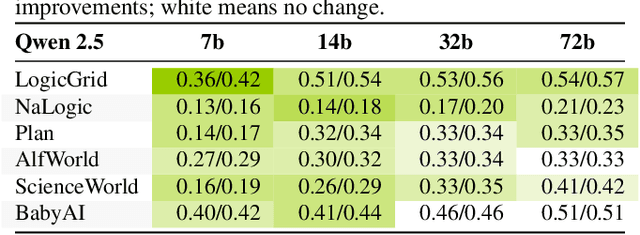

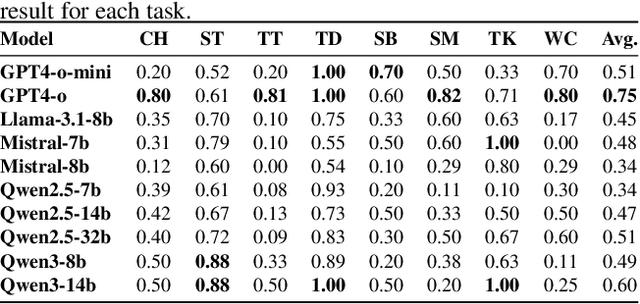
Abstract:Large language models (LLMs) have shown impressive capabilities across tasks such as mathematics, coding, and reasoning, yet their learning ability, which is crucial for adapting to dynamic environments and acquiring new knowledge, remains underexplored. In this work, we address this gap by introducing a framework inspired by cognitive psychology and education. Specifically, we decompose general learning ability into three distinct, complementary dimensions: Learning from Instructor (acquiring knowledge via explicit guidance), Learning from Concept (internalizing abstract structures and generalizing to new contexts), and Learning from Experience (adapting through accumulated exploration and feedback). We conduct a comprehensive empirical study across the three learning dimensions and identify several insightful findings, such as (i) interaction improves learning; (ii) conceptual understanding is scale-emergent and benefits larger models; and (iii) LLMs are effective few-shot learners but not many-shot learners. Based on our framework and empirical findings, we introduce a benchmark that provides a unified and realistic evaluation of LLMs' general learning abilities across three learning cognition dimensions. It enables diagnostic insights and supports evaluation and development of more adaptive and human-like models.
CoderAgent: Simulating Student Behavior for Personalized Programming Learning with Large Language Models
May 27, 2025Abstract:Personalized programming tutoring, such as exercise recommendation, can enhance learners' efficiency, motivation, and outcomes, which is increasingly important in modern digital education. However, the lack of sufficient and high-quality programming data, combined with the mismatch between offline evaluation and real-world learning, hinders the practical deployment of such systems. To address this challenge, many approaches attempt to simulate learner practice data, yet they often overlook the fine-grained, iterative nature of programming learning, resulting in a lack of interpretability and granularity. To fill this gap, we propose a LLM-based agent, CoderAgent, to simulate students' programming processes in a fine-grained manner without relying on real data. Specifically, we equip each human learner with an intelligent agent, the core of which lies in capturing the cognitive states of the human programming practice process. Inspired by ACT-R, a cognitive architecture framework, we design the structure of CoderAgent to align with human cognitive architecture by focusing on the mastery of programming knowledge and the application of coding ability. Recognizing the inherent patterns in multi-layered cognitive reasoning, we introduce the Programming Tree of Thought (PTOT), which breaks down the process into four steps: why, how, where, and what. This approach enables a detailed analysis of iterative problem-solving strategies. Finally, experimental evaluations on real-world datasets demonstrate that CoderAgent provides interpretable insights into learning trajectories and achieves accurate simulations, paving the way for personalized programming education.
Marigold: Affordable Adaptation of Diffusion-Based Image Generators for Image Analysis
May 14, 2025Abstract:The success of deep learning in computer vision over the past decade has hinged on large labeled datasets and strong pretrained models. In data-scarce settings, the quality of these pretrained models becomes crucial for effective transfer learning. Image classification and self-supervised learning have traditionally been the primary methods for pretraining CNNs and transformer-based architectures. Recently, the rise of text-to-image generative models, particularly those using denoising diffusion in a latent space, has introduced a new class of foundational models trained on massive, captioned image datasets. These models' ability to generate realistic images of unseen content suggests they possess a deep understanding of the visual world. In this work, we present Marigold, a family of conditional generative models and a fine-tuning protocol that extracts the knowledge from pretrained latent diffusion models like Stable Diffusion and adapts them for dense image analysis tasks, including monocular depth estimation, surface normals prediction, and intrinsic decomposition. Marigold requires minimal modification of the pre-trained latent diffusion model's architecture, trains with small synthetic datasets on a single GPU over a few days, and demonstrates state-of-the-art zero-shot generalization. Project page: https://marigoldcomputervision.github.io
A Framework for Benchmarking and Aligning Task-Planning Safety in LLM-Based Embodied Agents
Apr 20, 2025Abstract:Large Language Models (LLMs) exhibit substantial promise in enhancing task-planning capabilities within embodied agents due to their advanced reasoning and comprehension. However, the systemic safety of these agents remains an underexplored frontier. In this study, we present Safe-BeAl, an integrated framework for the measurement (SafePlan-Bench) and alignment (Safe-Align) of LLM-based embodied agents' behaviors. SafePlan-Bench establishes a comprehensive benchmark for evaluating task-planning safety, encompassing 2,027 daily tasks and corresponding environments distributed across 8 distinct hazard categories (e.g., Fire Hazard). Our empirical analysis reveals that even in the absence of adversarial inputs or malicious intent, LLM-based agents can exhibit unsafe behaviors. To mitigate these hazards, we propose Safe-Align, a method designed to integrate physical-world safety knowledge into LLM-based embodied agents while maintaining task-specific performance. Experiments across a variety of settings demonstrate that Safe-BeAl provides comprehensive safety validation, improving safety by 8.55 - 15.22%, compared to embodied agents based on GPT-4, while ensuring successful task completion.
LLM-powered Multi-agent Framework for Goal-oriented Learning in Intelligent Tutoring System
Jan 27, 2025



Abstract:Intelligent Tutoring Systems (ITSs) have revolutionized education by offering personalized learning experiences. However, as goal-oriented learning, which emphasizes efficiently achieving specific objectives, becomes increasingly important in professional contexts, existing ITSs often struggle to deliver this type of targeted learning experience. In this paper, we propose GenMentor, an LLM-powered multi-agent framework designed to deliver goal-oriented, personalized learning within ITS. GenMentor begins by accurately mapping learners' goals to required skills using a fine-tuned LLM trained on a custom goal-to-skill dataset. After identifying the skill gap, it schedules an efficient learning path using an evolving optimization approach, driven by a comprehensive and dynamic profile of learners' multifaceted status. Additionally, GenMentor tailors learning content with an exploration-drafting-integration mechanism to align with individual learner needs. Extensive automated and human evaluations demonstrate GenMentor's effectiveness in learning guidance and content quality. Furthermore, we have deployed it in practice and also implemented it as an application. Practical human study with professional learners further highlights its effectiveness in goal alignment and resource targeting, leading to enhanced personalization. Supplementary resources are available at https://github.com/GeminiLight/gen-mentor.
Flash-Split: 2D Reflection Removal with Flash Cues and Latent Diffusion Separation
Dec 31, 2024
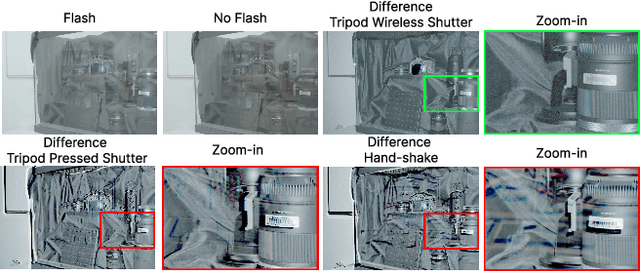
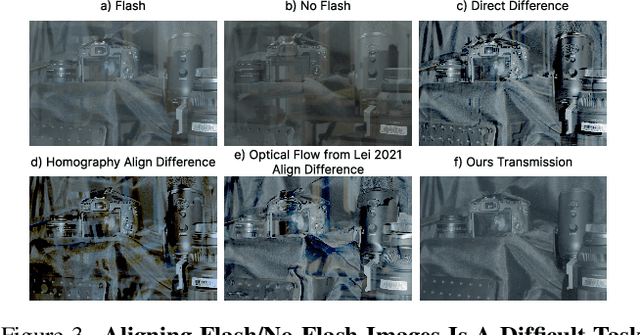

Abstract:Transparent surfaces, such as glass, create complex reflections that obscure images and challenge downstream computer vision applications. We introduce Flash-Split, a robust framework for separating transmitted and reflected light using a single (potentially misaligned) pair of flash/no-flash images. Our core idea is to perform latent-space reflection separation while leveraging the flash cues. Specifically, Flash-Split consists of two stages. Stage 1 separates apart the reflection latent and transmission latent via a dual-branch diffusion model conditioned on an encoded flash/no-flash latent pair, effectively mitigating the flash/no-flash misalignment issue. Stage 2 restores high-resolution, faithful details to the separated latents, via a cross-latent decoding process conditioned on the original images before separation. By validating Flash-Split on challenging real-world scenes, we demonstrate state-of-the-art reflection separation performance and significantly outperform the baseline methods.
Repurposing Pre-trained Video Diffusion Models for Event-based Video Interpolation
Dec 10, 2024



Abstract:Video Frame Interpolation aims to recover realistic missing frames between observed frames, generating a high-frame-rate video from a low-frame-rate video. However, without additional guidance, the large motion between frames makes this problem ill-posed. Event-based Video Frame Interpolation (EVFI) addresses this challenge by using sparse, high-temporal-resolution event measurements as motion guidance. This guidance allows EVFI methods to significantly outperform frame-only methods. However, to date, EVFI methods have relied on a limited set of paired event-frame training data, severely limiting their performance and generalization capabilities. In this work, we overcome the limited data challenge by adapting pre-trained video diffusion models trained on internet-scale datasets to EVFI. We experimentally validate our approach on real-world EVFI datasets, including a new one that we introduce. Our method outperforms existing methods and generalizes across cameras far better than existing approaches.
MILLION: A General Multi-Objective Framework with Controllable Risk for Portfolio Management
Dec 04, 2024



Abstract:Portfolio management is an important yet challenging task in AI for FinTech, which aims to allocate investors' budgets among different assets to balance the risk and return of an investment. In this study, we propose a general Multi-objectIve framework with controLLable rIsk for pOrtfolio maNagement (MILLION), which consists of two main phases, i.e., return-related maximization and risk control. Specifically, in the return-related maximization phase, we introduce two auxiliary objectives, i.e., return rate prediction, and return rate ranking, combined with portfolio optimization to remit the overfitting problem and improve the generalization of the trained model to future markets. Subsequently, in the risk control phase, we propose two methods, i.e., portfolio interpolation and portfolio improvement, to achieve fine-grained risk control and fast risk adaption to a user-specified risk level. For the portfolio interpolation method, we theoretically prove that the risk can be perfectly controlled if the to-be-set risk level is in a proper interval. In addition, we also show that the return rate of the adjusted portfolio after portfolio interpolation is no less than that of the min-variance optimization, as long as the model in the reward maximization phase is effective. Furthermore, the portfolio improvement method can achieve greater return rates while keeping the same risk level compared to portfolio interpolation. Extensive experiments are conducted on three real-world datasets. The results demonstrate the effectiveness and efficiency of the proposed framework.
Efficient Data-aware Distance Comparison Operations for High-Dimensional Approximate Nearest Neighbor Search
Nov 26, 2024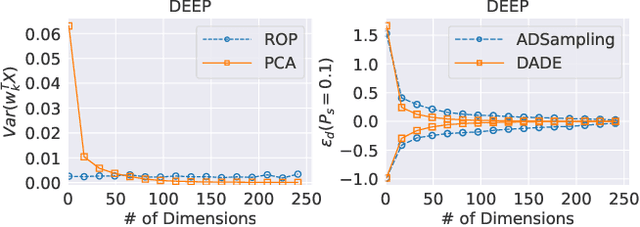
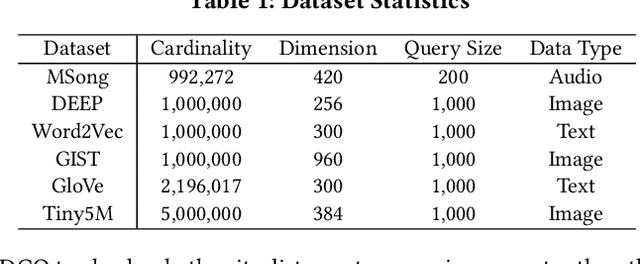
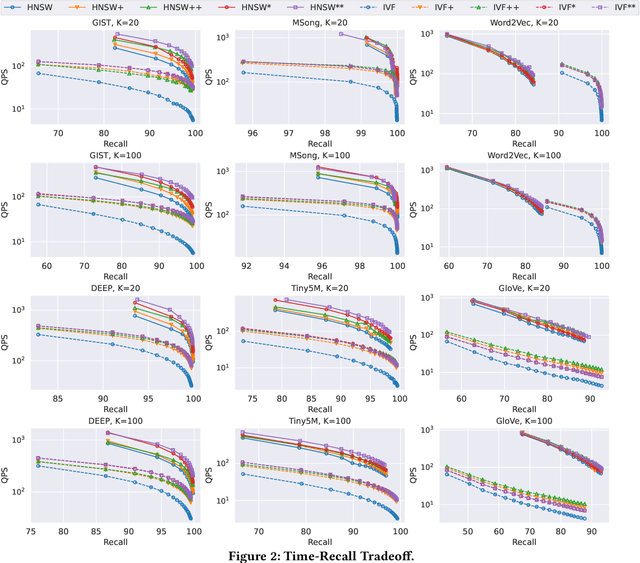
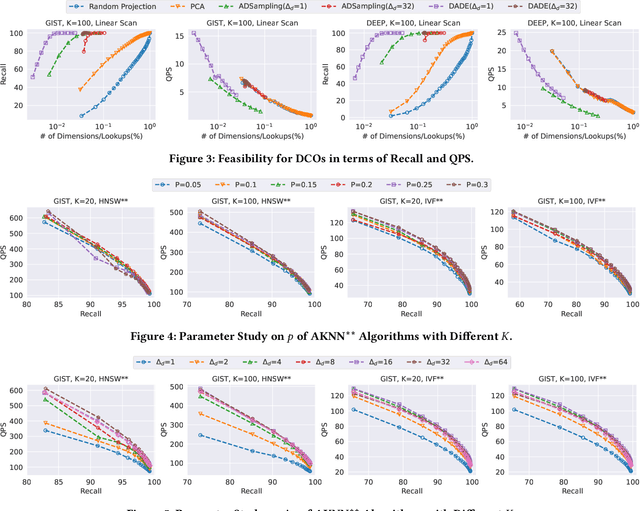
Abstract:High-dimensional approximate $K$ nearest neighbor search (AKNN) is a fundamental task for various applications, including information retrieval. Most existing algorithms for AKNN can be decomposed into two main components, i.e., candidate generation and distance comparison operations (DCOs). While different methods have unique ways of generating candidates, they all share the same DCO process. In this study, we focus on accelerating the process of DCOs that dominates the time cost in most existing AKNN algorithms. To achieve this, we propose an \underline{D}ata-\underline{A}ware \underline{D}istance \underline{E}stimation approach, called \emph{DADE}, which approximates the \emph{exact} distance in a lower-dimensional space. We theoretically prove that the distance estimation in \emph{DADE} is \emph{unbiased} in terms of data distribution. Furthermore, we propose an optimized estimation based on the unbiased distance estimation formulation. In addition, we propose a hypothesis testing approach to adaptively determine the number of dimensions needed to estimate the \emph{exact} distance with sufficient confidence. We integrate \emph{DADE} into widely-used AKNN search algorithms, e.g., \emph{IVF} and \emph{HNSW}, and conduct extensive experiments to demonstrate the superiority.
 Add to Chrome
Add to Chrome Add to Firefox
Add to Firefox Add to Edge
Add to Edge